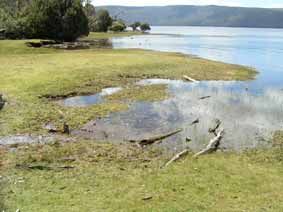Major Group: Insecta
Order: Coleoptera
Family: Hygrobiidae
Genus: Hygrobia
This family is represented by a single genus worldwide, Hygrobia. |
Descriptive Features:
Adults
head exsert
eyes protuberant, well separated from anterior edge of prothorax
antennae entirely or almost entirely glabrous, length greater than 1 mm
prothorax with pair of notopleural sutures (distinct from sharp lateral margins) separating notum from externally visible pleuron on each side
abdomen with ventrite 1 divided into 2 or 3 parts by hind coxae
metasternum with transverse suture
mesocoxal cavities open laterally (partly closed by mesepimeron)
metacoxae relatively small, their lateral portions shorter than metasternum, extending laterally to meet elytra, so that junction of metepimera and first ventrite is not visible
metacoxal plates absent or consisting of narrow mesal portion only
fore tibia without antenna cleaner
tarsi always 5-segmented
size: up to 10mm
Larvae
head large
legs present
labrum completely fused to head
body compact
abdominal tergum 8 terminal, elongated to apical segment
2 long cerci (with elongated segment appears 3 pronged)
setose gills beneath thorax and abdominal segments 1-3
size: |

|
Hygrobia larva |
|
|

|
Hygrobia australasiae adult |
|
Taxonomic Checklist: Species
Hygrobia australasiae Clark
Hygrobia maculata Britton (larva unknown)
Hygrobia niger Clark (larva unknown)
Hygrobia wattsi Hendrich |
|
Distribution: N NT, E Qld, E NSW, S Vic, S SA, SW WA, Tas
Sensitivity Rating: SIGNAL grade 1
Functional Feeding Group: predators |

|
Lake St Clair in Cradle Mountain-Lake St Clair NP, Tas |
|
|
Ecology: Commonly known as ‘screech beetles’, Australian species of Hygrobiidae are all rare.
Instream habitat: Adult and larval hygrobid beetles occur in stagnant water where the bottom is covered with a fine ooze of mud and rotten plant debris.
Feeding ecology:Both larvae and adults are bottom-feeding predators with a very specialized diet of tubificid worms (Oligochaeta: Tubificidae) and/or chironomid larvae (Diptera: Chironomidae).
Habit: Hygrobid beetles are relatively slow moving.
Life history: Pupation, in European species, is in cells dug into damp ground at the edge of ponds and dams.
|
| |
Information Sources: Watts 2002, Lawrence & Britton 1991, Lawrence et al. 2001, Gooderham & Tsyrlin 2002. Alarie et al. 2004
Key to Species: Britton 1981 (adults), Alarie et al 2004 (larvae world) |
|
|
|